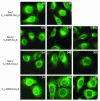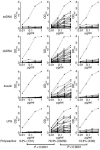Unmutated and mutated chronic lymphocytic leukemias derive from self-reactive B cell precursors despite expressing different antibody reactivity
- PMID: 15902303
- PMCID: PMC1088018
- DOI: 10.1172/JCI24387
Unmutated and mutated chronic lymphocytic leukemias derive from self-reactive B cell precursors despite expressing different antibody reactivity
Abstract
B cell chronic lymphocytic leukemia (CLL) is a disease of expanding monoclonal B cells whose B cell receptor (BCR) mutational status defines 2 subgroups; patients with mutated BCRs have a more favorable prognosis than those with unmutated BCRs. CLL B cells express a restricted BCR repertoire including antibodies with quasi-identical complementarity-determining region 3 (CDR3), which suggests specific antigen recognition. The antigens recognized by CLL antibodies may include autoantigens since about half of CLL B cells produce autoreactive antibodies. However, the distribution of autoreactive antibodies between Ig heavy-chain variable-unmutated (IgV-unmutated) CLL (UM-CLL) and IgV-mutated CLL (M-CLL) is unknown. To determine the role of antibody reactivity and the impact of somatic hypermutation (SHM) on CLL antibody specificity, we cloned and expressed in vitro recombinant antibodies from M- and UM-CLL B cells and tested their reactivity by ELISA. We found that UM-CLL B cells expressed highly polyreactive antibodies whereas most M-CLL B cells did not. When mutated nonautoreactive CLL antibody sequences were reverted in vitro to their germline counterparts, they encoded polyreactive and autoreactive antibodies. We concluded that both UM-CLLs and M-CLLs originate from self-reactive B cell precursors and that SHM plays an important role in the development of the disease by altering original BCR autoreactivity.
Figures







Similar articles
-
Molecular and clinical features of chronic lymphocytic leukaemia with stereotyped B cell receptors: results from an Italian multicentre study.Br J Haematol. 2009 Feb;144(4):492-506. doi: 10.1111/j.1365-2141.2008.07469.x. Epub 2008 Nov 19. Br J Haematol. 2009. PMID: 19036101
-
IgG+, CD5+ human chronic lymphocytic leukemia B cells. Production of IgG antibodies that exhibit diminished autoreactivity and IgG subclass skewing.Autoimmunity. 1994;19(1):39-48. doi: 10.3109/08916939409008007. Autoimmunity. 1994. PMID: 7538331
-
The Traf2DNxBCL2-tg Mouse Model of Chronic Lymphocytic Leukemia/Small Lymphocytic Lymphoma Recapitulates the Biased IGHV Gene Usage, Stereotypy, and Antigen-Specific HCDR3 Selection of Its Human Counterpart.Front Immunol. 2021 Apr 12;12:627602. doi: 10.3389/fimmu.2021.627602. eCollection 2021. Front Immunol. 2021. PMID: 33912159 Free PMC article.
-
What do somatic hypermutation and class switch recombination teach us about chronic lymphocytic leukaemia pathogenesis?Curr Top Microbiol Immunol. 2005;294:71-89. doi: 10.1007/3-540-29933-5_5. Curr Top Microbiol Immunol. 2005. PMID: 16323428 Review.
-
The immunoglobulin genes and chronic lymphocytic leukemia (CLL).Ups J Med Sci. 2005;110(2):97-113. doi: 10.3109/2000-1967-075. Ups J Med Sci. 2005. PMID: 16075892 Review.
Cited by
-
Somatic hypermutations confer rheumatoid factor activity in hepatitis C virus-associated mixed cryoglobulinemia.Arthritis Rheum. 2013 Sep;65(9):2430-40. doi: 10.1002/art.38041. Arthritis Rheum. 2013. PMID: 23754128 Free PMC article.
-
Higher-order connections between stereotyped subsets: implications for improved patient classification in CLL.Blood. 2021 Mar 11;137(10):1365-1376. doi: 10.1182/blood.2020007039. Blood. 2021. PMID: 32992344 Free PMC article.
-
Stereotyped B-cell receptors in one-third of chronic lymphocytic leukemia: a molecular classification with implications for targeted therapies.Blood. 2012 May 10;119(19):4467-75. doi: 10.1182/blood-2011-11-393694. Epub 2012 Mar 13. Blood. 2012. PMID: 22415752 Free PMC article.
-
Pathophysiology of chronic lymphocytic leukemia and human B1 cell development.Int J Hematol. 2020 May;111(5):634-641. doi: 10.1007/s12185-019-02788-7. Epub 2019 Dec 3. Int J Hematol. 2020. PMID: 31797231 Review.
-
Intraclonal cell expansion and selection driven by B cell receptor in chronic lymphocytic leukemia.Mol Med. 2011;17(7-8):834-9. doi: 10.2119/molmed.2011.00047. Epub 2011 Apr 28. Mol Med. 2011. PMID: 21541442 Free PMC article.
References
-
- Rajewsky K. Clonal selection and learning in the antibody system. Nature. 1996;381:751–758. - PubMed
-
- Meffre E, Casellas R, Nussenzweig MC. Antibody regulation of B cell development. Nat. Immunol. 2000;1:379–385. - PubMed
-
- Schroeder HW, Jr, Dighiero G. The pathogenesis of chronic lymphocytic leukemia: analysis of the antibody repertoire [review] Immunol. Today. 1994;15:288–294. - PubMed
-
- Damle RN, et al. Ig V gene mutation status and CD38 expression as novel prognostic indicators in chronic lymphocytic leukemia. Blood. 1999;94:1840–1847. - PubMed
Publication types
MeSH terms
Substances
Grants and funding
LinkOut - more resources
Full Text Sources
Other Literature Sources

